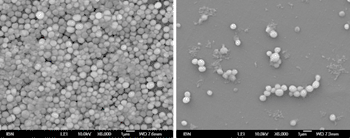Antimicrobial Hydrogels Dissolve and Sterilize Drug-Resistant Biofilms
By LabMedica International staff writers
Posted on 04 Feb 2013
Synthetic antimicrobial hydrogels have been developed that demonstrate 100% efficiency in destruction of biofilms, with application potential for catheter and medical device coatings, implants, skin, and everyday surfaces.Posted on 04 Feb 2013
Bacterial biofilms, which are adhesive groupings of pathogenic cells present in 80% of all infections, develop on the skin and on medical devices and household surfaces where they are difficult to treat and demonstrate high resistance to antibiotics.
In the current study, which was published in the January 7, 2013, issue of the journal, Angewandte Chemie, investigators at IBM (San Jose, CA, USA) and the Institute of Bioengineering and Nanotechnology (Singapore) described the development of biodegradable and injectable/moldable hydrogels with hierarchical nanostructures. These 90% aqueous hydrogels were made from specifically designed macromolecules containing a large number of atoms, which combined water solubility, positive charge, and biodegradability characteristics. When mixed with water and warmed to body temperature the polymers self-assembled, swelling into a synthetic gel that was easy to manipulate.
The hydrogels were shown to possess broad-spectrum antimicrobial activities and biofilm-disruption capability. Furthermore, they demonstrated no cytotoxicity in vitro, and displayed excellent skin biocompatibility in animals.
"This is a fundamentally different approach to fighting drug-resistant biofilms. When compared to capabilities of modern-day antibiotics and hydrogels, this new technology carries immense potential,” said Dr. James Hedrick, advanced organic materials scientist at IBM. “This new technology is appearing at a crucial time as traditional chemical and biological techniques for dealing with drug-resistant bacteria and infectious diseases are increasingly problematic.”
“We were driven to develop a more effective therapy against super bugs due to the lethal threat of infection by these rapidly mutating microbes and the lack of novel antimicrobial drugs to fight them. Using the inexpensive and versatile polymer materials that we have developed jointly with IBM, we can now launch a nimble, multipronged attack on drug-resistant biofilms which would help to improve medical and health outcomes,” said Dr. Yi-Yan Yang, group leader at the Institute of Bioengineering and Nanotechnology.
Related Links:
IBM
Institute of Bioengineering and Nanotechnology











 Analyzer.jpg)




